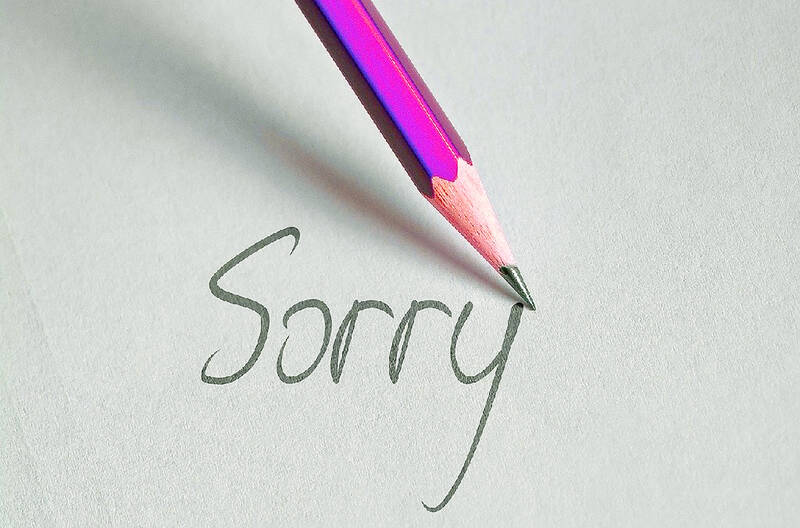BBC曾在旅遊版刊出了一篇名為《The Island That Never Stops Apologizing》的文章,稱台灣為一個不斷道歉的島嶼,原因是台灣人常在生活上說「不好意思」,甚至以「不好意思」用做發語詞。在日常生活中,我們也有需要表達歉意的場合,但如何說抱歉,何時說抱歉卻因文化和風俗民情產生差異。話不多說,就讓我們來學學表達抱歉的英語口說方式,也是TOEIC測驗常見的用語喔!
從小錯誤到正式道歉
在發生一般小錯誤時,可以用 My bad!(我的錯!)來表達歉意。這個表現方式較常出現在美式英語中,意思即是I admit that it’s my fault。除了My Bad,你也可以用(It’s) My fault! 或 (It’s) My mistake!來表達歉意。

Photo: Pixabay I 照片:Pixabay 提供
而我們最常用來表達歉意的sorry,則可用在不同程度的錯誤,比如當我們不小心撞到人時,到較嚴重的錯誤都可用(I’m) Sorry about that。
如果要說明對什麼事情感到抱歉時,就可以用for +原因。for 為介系詞,所以後面需加名詞或動名詞。
I’m sorry for being late.
(抱歉,我遲到了。)
過去可能犯下的錯誤
另外,因為may 和might常用在「可能」(並非100%的肯定)的狀況,所以可以用may/might have + Vp.p. 來表示對過去可能犯下的錯誤。
I’m sorry for any inconvenience / problems that I may have caused.
(我對可能所造成的不便/問題感到抱歉。)
此外,也可以用should have + Vp.p. 或shouldn’t Vp.p.來表示過去「應該」或「不應該」的一種後悔或懊悔。
I should have checked the quality of our products more thoroughly.
(我應該更仔細的檢查產品的品質。)
I’m sorry, I shouldn’t have done that.
(抱歉,我不應該那樣做。)
如果要表達當時並非有意這樣做時的這種較無心之過,也可用I didn’t mean to V。
I didn’t mean to hurt your feelings.
(我不是故意要讓你難過或不舒服。)
較正式的道歉
如果是較正式的道歉或書面上的道歉,一般上會用 apologize (v)、apology (n) 來表示,而介系詞則是用for。
1. I’d like to apologize for. . . .(我想為……而道歉)
2. I sincerely apologize.(我真誠地道歉。)
3. I owe you an apology.(我欠你一個道歉)
4. My (sincere / deepest) apologies.(我最深切的道歉。)
5. Please accept my apologies for. . . .(請接受我……的道歉)
6. I apologize for the error on the invoice.(我對發票上的錯誤感到抱歉。)
當人家跟你道歉時,如果你願意原諒,則可簡單地說apology accepted(也就是I accept your apology)。
此外,也可以用下面的表現方式來表示歉意外,並且願意負責。
I take full responsibility for my behavior / actions.
(我會對我的行為負全責。)
遺憾、抱歉、後悔
sorry 除了表現道歉,在某些情況下也可以表達「遺憾」,尤其是在聽到壞消息或要告知別人不好或失望的消息。譬如說,如果聽到某人的家人過世,或某人考試沒有通過,你可說I’m sorry to hear that.
I’m sorry for your loss.
(我對你失去親人感到遺憾。)
I’m so sorry to hear of the death of your mother.
(我對你母親逝世的消息感到遺憾。)
而在英文書信上,sorry也常常被用到:
We’re sorry to inform you that you have not passed the exam.
(我們很遺憾地通知你沒有通過考試。)
除了sorry,regret「遺憾」也可以當作動詞或名詞,做「遺憾、抱歉」或「後悔」解釋。
We regret any inconvenience caused by our delay in production.
(我們對於我方延誤生產所造成的不便感到抱歉。)
當「後悔」時,regret後面的動詞要用「-ing」的形式。
I don’t regret relocating to New York.
(我不後悔搬到紐約。)
不好意思
此外還有幾個場合,我們常常會用「對不起」或「不好意思」,但是英文不用sorry。譬如說跟人家借過,請人讓一讓,或在餐廳裡要請侍者過來,找人問路等情況,我們可以用Excuse me! 或 Pardon (me)!
Excuse me, can you tell me how to get to Taipei 101?
(不好意思,請問你可以告訴我如何去台北101嗎?)
甚至打噴嚏時也是說 excuse me.如果沒聽清楚別人說什麼,或希望對方能再說一次時,也可以用上揚的語調說Excuse me?、I beg your pardon?、Sorry?。
最後,如果是犯了錯誤或讓人覺得不舒服時,通常是用sorry;而在覺得不好意思要請人做事時,就常用Excuse me。
【TOEIC多益模擬試題】
1. We __________ our overhead expenses. As a result, we are currently operating at a loss.
(A) shouldn’t have underestimated
(B) should have been underestimated
(C) have not underestimated
(D) should underestimating
2. We regret _______ you that you have not been shortlisted for the interview.
(A) inform
(B) to inform
(C) information
(D) informative
【解析】
1. 本題為文法題。對過去的不應該的後悔需用should have + Vp.p.。本題題意為「我們不應該低估我們的營運成本。結果,我們現在處於損失的狀態。」因此,正確答案為(A)。(B)是被動式,(C)和(D)的語意和後面句子「處於損失的狀態」的意思不合。
2. 本題正確答案為(B)。本題為文法題,題意為「我們很遺憾的通知你你沒被選上參加面試。」由於是表示遺憾通知失望的消息,因此使用to V。如果是「後悔通知」,則會用regret informing。
SOURCE:https://www.englishok.com.tw/toeic/workplace-toeic/apologize-sorry-english-speaking-words
文章由TOEIC Program Taiwan · Chun Shin提供:
www.facebook.com/ToeicProgramTaiwan

If you’ve recently spotted adults parading around with cuddly toys dangling from their designer handbags, your eyes haven’t been deceiving you. The playful trend of adorning bags with cute charms has become popular among people of various ages. Plushies like Labubu and anime and manga characters such as Chiikawa have become must-have accessories that make personal statements. The practice of attaching charms to personal items has been common across cultures throughout history. In ancient civilizations, charms were often used as symbols of protection, good luck, or identity. Fast-forward to more modern times, and style icons like Jane Birkin, a

A: Apart from Jin Yong, the late martial arts novelists Liang Yusheng and Gu Long were also very popular. B: Wasn’t Liang a pioneer of the “new school” wuxia genre in the 20th century? A: Yup, I really like his Tianshan mountain series. All the characters — such as the “White Haired Demoness” — are so vivid. B: The roles in Gu’s books are lively, too — like the “Fragrant Commander” Chu Liuxiang. A: And the TV drama adapted from the Chu Liuxiang series swept across Taiwan in the 1980s, with ratings surging over 70 percent at that time.

★ Bilingual Story is a fictionalized account. 雙語故事部分內容純屬虛構。 Kevin leaned over the bubbling pot. “Hey. . . are you okay? You’ve barely touched your food.” Zoey blinked. Her face was red — not from blushing, but from the “mala” spice and the heat of the room. Her blond hair clumped to her face like strands of fine spaghetti. Her carefully applied makeup now streaked. “This isn’t what I expected,” she said softly, forcing a smile. All around them, Kevin’s friends were laughing, shouting, and tossing ingredients into the broth. The air smelled of chili oil and garlic.

Continued from yesterday(延續自昨日) https://www.taipeitimes.com/News/lang If plushie charms are cute little nods to people’s interests, ita bags are full-on declarations. The term “ita” comes from the Japanese word itai, which means “painful” and reflects the overwhelming visual intensity of these bags. An ita bag is essentially a handbag, backpack, or tote meticulously decorated with an extensive collection of merchandise dedicated to a specific character or idol. These bags usually feature a clear plastic window to display carefully arranged pins, badges, keychains, or fan art. Both the interior and exterior may be covered in fandom memorabilia, creating an aesthetic so intense that it’s almost “painful”